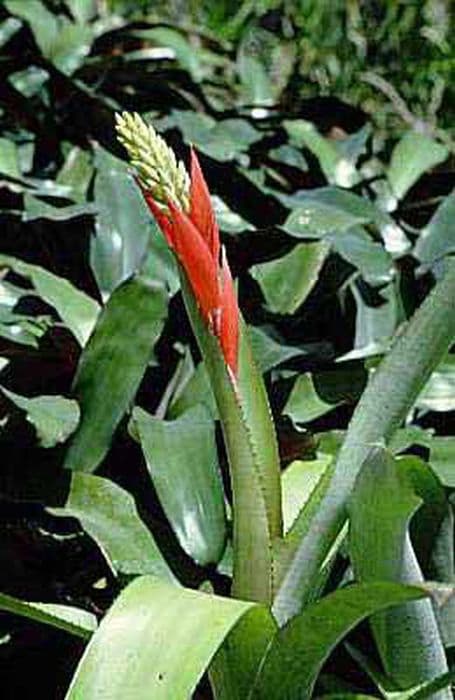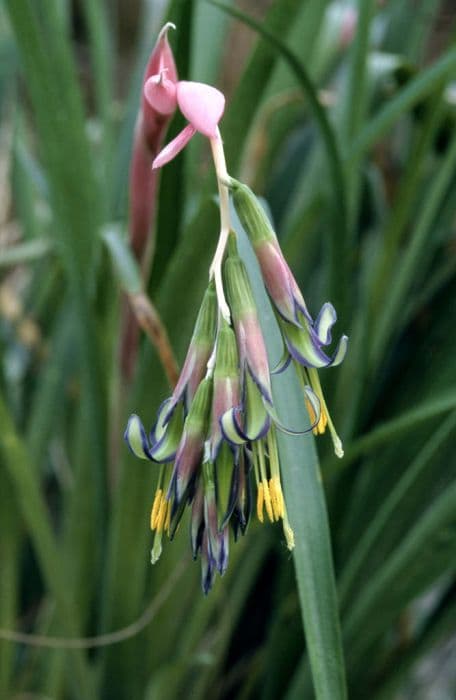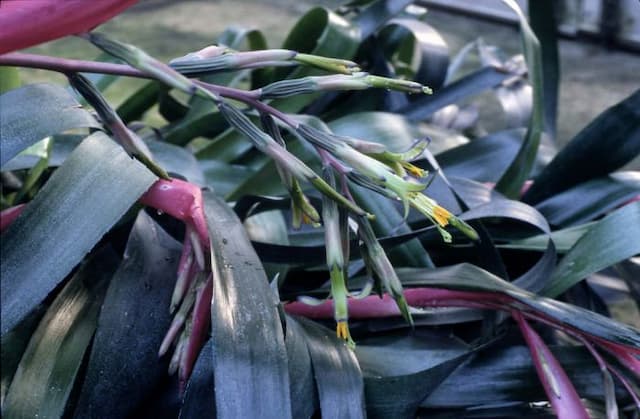Rush-like air plant Tillandsia juncea

ABOUT
T. juncea is an evergreen, epiphytic perennial to 40cm tall with long, slender, grey-green, grass-like leaves and small purple flowers emerging from red bracts in the spring and summer
About this plant
 Names
NamesSynonyms
Rush Tillandsia, Banded Air Plant, Pencil Plant.
Common names
Tillandsia juncea.
 Characteristics
CharacteristicsLife cycle
Perennials
Foliage type
Evergreen
Color of leaves
Green
Flower color
Varies
Height
1-2 feet (30-60 cm)
Spread
1 foot (30 cm)
Plant type
Herb
Hardiness zones
9
Native area
South America
Benefits
 General Benefits
General Benefits- Low Maintenance: Tillandsia juncea, commonly known as "Juncea Air Plant," requires minimal watering and no soil, making it easy to care for.
- Adaptability: This air plant can thrive in various light conditions, from bright indirect light to lower light environments.
- Drought Tolerance: Known for its ability to withstand periods of drought, Juncea Air Plant is ideal for busy or forgetful caretakers.
- Interior Decoration: With its grass-like appearance, it adds a unique touch to home decor, fitting well in modern and minimalist designs.
- Versatility in Display: Can be displayed in numerous ways, such as in terrariums, mounted on objects, or in specialized air plant holders.
- Long Bloom Cycle: When it flowers, the Juncea Air Plant has a long-lasting bloom period, which adds beauty and interest.
- Non-Toxicity: Safe for households with pets as it's non-toxic if accidentally ingested by animals.
- Propagation Ease: Offsets, also known as "pups," can easily be removed to grow new plants, making propagation straightforward.
 Medical Properties
Medical PropertiesThis plant is not used for medical purposes.
 Air-purifying Qualities
Air-purifying QualitiesThis plant is not specifically known for air purifying qualities.
 Other Uses
Other Uses- Tillandsia juncea, commonly known as Spanish moss, is often used as a natural adornment in aquariums, where it both adds aesthetic appeal and can provide hiding spaces for small fish and invertebrates.
- Due to its ability to absorb and retain water, Spanish moss can be used as a biodegradable packing material for fragile items.
- In fine art, Spanish moss is sometimes incorporated into sculptures and installations, especially to convey a sense of organic texture or southern gothic style.
- Spanish moss can be used in terrariums, providing a natural-looking element that helps maintain humidity for moisture-loving plants and creatures.
- In floral arrangements, Spanish moss is used to add greenery, drape around structures, or provide a bed for laying out the design components.
- As a craft material, Spanish moss can be fashioned into wreaths, garlands, or other decorative items particularly popular for rustic-themed events.
- In the fashion industry, strands of Spanish moss have been used to create unique and striking natural jewelry pieces, like necklaces or earrings.
- For educational purposes, Spanish moss can be used to demonstrate the lifecycle and features of epiphytes (plants that grow on other plants) without harming their hosts.
- In photography, Spanish moss is often used to create a moody and atmospheric backdrop for outdoor portraits and nature photography.
- In landscaping, Spanish moss can be draped over outdoor structures like arbors or trellises to provide an instant aged and mystical feel to gardens and yards.
Interesting Facts
 Feng Shui
Feng ShuiThe Tillandsia, also known as air plant, can be used in Feng Shui to bring positive energy and improve air quality in the home. They are often placed in the wealth corner of a room or in areas where the flow of chi (energy) needs to be improved due to their easy-to-care-for nature and their ability to thrive without soil.
 Zodiac Sign Compitability
Zodiac Sign CompitabilityThe Tillandsia is not used in astrology practice.
 Plant Symbolism
Plant Symbolism- Resilience: The Tillandsia juncea, commonly known as the "Needle Leaf Air Plant," is known for its resilience as it can grow with minimal soil and water, which symbolizes the ability to overcome challenging conditions and adapt to various environments.
- Independence: As an air plant, the Needle Leaf Air Plant absorbs moisture and nutrients through its leaves from the air, which symbolizes self-sufficiency and the ability to thrive without relying on others.
- Freedom: The lack of need for soil allows the Needle Leaf Air Plant to grow in various spaces, representing freedom from conventional limitations and the ability to chart one's own path.
 Water
WaterThe Rush Tillandsia should be watered by misting or soaking once a week, depending on the humidity levels of its environment. In dryer conditions, you may increase watering to twice a week by misting thoroughly or soaking for up to an hour. When soaking, submerge the plant in water, and shake it gently afterwards to remove excess water. Always allow the plant to dry fully within four hours after soaking to prevent rot. During winter, reduce watering to once every two to three weeks as the plant's growth slows down.
 Light
LightThe Rush Tillandsia thrives in bright, indirect sunlight. Position the plant within three to five feet of a window where it can receive plenty of light without being exposed to the harsh rays of the direct sun. A spot near an east or west-facing window is ideal, offering the right balance of light throughout the day.
 Temperature
TemperatureThe Rush Tillandsia prefers warm temperatures ranging from 50 to 90 degrees Fahrenheit, with an ideal range between 60 and 80 degrees. It can withstand temperatures as low as 50 degrees at night, but should not be exposed to temperatures below 45 degrees as it may cause the plant to suffer. Ensure a consistent temperature range to maintain the plant's health.
 Pruning
PruningPruning the Rush Tillandsia is primarily for aesthetic reasons and to remove any dead or damaged leaves. Prune by gently pulling away the unwanted leaves or using a pair of scissors for a clean cut. The best time to prune is during the spring or early summer when the plant is actively growing. Pruning can be done as needed, whenever you notice dead or unsightly leaves.
 Cleaning
CleaningAs needed
 Soil
SoilTillandsia juncea, commonly known as pencil plant, doesn't require soil, as it's an air plant that absorbs moisture and nutrients through its leaves. For best care, mount it on a substrate like wood or place it within a well-ventilated container. The pH of the surrounding environment should ideally be neutral to slightly acidic, but since it doesn't grow in soil, pH isn't a critical factor.
 Repotting
RepottingPencil plant, or Tillandsia juncea, rarely needs repotting as it does not grow in soil. Instead, ensure its mounting surface is clean and secure. Repotting is not applicable to this air plant; it may just need remounting occasionally.
 Humidity & Misting
Humidity & MistingPencil plant, or Tillandsia juncea, thrives in high humidity conditions, ideally above 60%. They prefer moist air, which mimics their native tropical and subtropical habitats, but do not require watering like traditional potted plants.
 Suitable locations
Suitable locationsIndoor
Mount on bark or place in a terrarium for optimal indoor growth.
Outdoor
Attach to wood or hang, provide bright, indirect light.
Hardiness zone
9-11 USDA
 Life cycle
Life cycleThe life of Tillandsia juncea, commonly known as Rush-leaved Tillandsia, begins with seed germination, which requires exposure to light and air circulation. As an epiphyte, the seedling develops by anchoring its roots to a suitable host, such as a tree or rock, for support rather than for nutrient uptake. The plant then grows by absorbing water and nutrients through its leaves from the air and rainfall, a process known as CAM photosynthesis, which is typical for species in the Bromeliaceae family. During its growth phase, it produces narrow, stiff leaves that form a rosette shape. Once mature, Rush-leaved Tillandsia blooms with purple or yellow flowers, followed by the production of seed capsules if pollination occurs. After flowering, which may take several years to occur, the plant will gradually senesce and die, while the seeds disperse to begin new life cycles.
 Propogation
PropogationPropogation time
Spring to Summer
Tillandsia juncea, commonly known as the Broom air plant, is typically propagated through the division of offsets, also called "pups." These are small plants that form at the base of the parent plant. The best time to propagate Tillandsia juncea is during the spring or early summer, when the plant is actively growing. To propagate through division, you should wait until the pup is about one-third the size of the parent plant. Carefully remove the pup by gently pulling it apart from the parent plant or using a sterilized knife or scissors if necessary. It is important not to damage the base of the pup where the new roots will emerge. After separating the pup, it can be mounted on a suitable substrate or placed in a well-ventilated area to begin its own growth cycle. This method is favored for its simplicity and effectiveness in producing new, independent plants.









